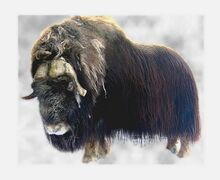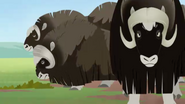
The musk oxen (Ovibos moschatus, muskox) is a large Arctic mammal of the Bovidae family.
It has a thick coat, and was common in the northern hemisphere during the Pleistocene ice age. The males give off a strong odour, hence its name. This musky odour is used to attract females during mating season. Muskoxen travel in herds of females and their young led by one or two strong males. Male oxen fight over who will be leader by butting their thick heads and horns against each other. The musk oxen's long, curved horns keep away predators. When a herd smells nearby wolves, all the musk oxen form a circle and face out. They lower their heads to show off their horns.
Muskoxen live in Arctic North America and Greenland, with small introduced populations in Sweden, Siberia and Norway.
Muskoxen are herbivores which graze on grasses, leaves, and some Arctic flowers. They are ruminants; they swallow their food without chewing it. Later, they regurgitate the food (called a cud) and chew it. Muskoxen, like other ruminants, have a stomach with four sections.
Fossil DNA evidence suggests muskoxen were not only more geographically widespread during the Pleistocene, but also more genetically diverse. During that time, other populations of muskoxen lived across the Arctic, from the Ural Mountains to Greenland. Together with the bison and the pronghorn, the muskox was one of a few species of Pleistocene megafauna in North America to survive the Pleistocene/Holocene extinction event and live to the present day.




